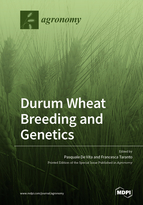Durum Wheat Breeding and Genetics
A special issue of Agronomy (ISSN 2073-4395). This special issue belongs to the section "Crop Breeding and Genetics".
Deadline for manuscript submissions: closed (31 May 2020) | Viewed by 43217
Special Issue Editors
Interests: durum wheat breeding and genetics; yield and grain quality; mapping QTL; marker-assisted selection; wheat biofortification
Interests: molecular biology and genetics; genomics; genotype-by-sequencing (GBS); Mapping QTL; genome-wide association study (GWAS)
Special Issues, Collections and Topics in MDPI journals
Special Issue Information
Dear Colleagues,
Durum wheat is the raw material of the pasta production industry and, although less widespread than bread wheat, it has become a very important cereal product on the world market together with the increase in the demand for pasta. Considering the main distribution area of durum wheat in the Mediterranean area, which is characterized by rainy winters and dry summers, the genetic improvement of stress-related traits was usually approached by breeding directly for yield in potential environments subject to low abiotic stress. According to the main climate scenarios, the expected growth of the average annual temperature in the Mediterranean region will be slightly higher than that of the world level. Under these conditions, the production of durum wheat is threatened by the impacts of climate change, and there is a need for more sustainable development.
In this Special Issue we welcome research papers and reviews (a reduced number) dealing with topics related to the genetic improvement of durum wheat with particular reference to the key traits to increase productivity and grain quality despite increasing water scarcity, higher temperatures, and the emergence of new pests and diseases. The integration of -omics technologies is promising to revolutionize plant breeding, providing an exceptional opportunity to identify genetic variations that can be employed in durum wheat breeding programs. For these reasons, contributions highlighting the usefulness of new genotyping, phenotyping and modelling techniques to improve the understanding and prediction of complex traits (e.g. yield, protein content, interaction with weeds and soil micro-organisms, etc.), are welcome.
Dr. Pasquale De Vita
Dr. Francesca Taranto
Guest Editors
Manuscript Submission Information
Manuscripts should be submitted online at www.mdpi.com by registering and logging in to this website. Once you are registered, click here to go to the submission form. Manuscripts can be submitted until the deadline. All submissions that pass pre-check are peer-reviewed. Accepted papers will be published continuously in the journal (as soon as accepted) and will be listed together on the special issue website. Research articles, review articles as well as short communications are invited. For planned papers, a title and short abstract (about 100 words) can be sent to the Editorial Office for announcement on this website.
Submitted manuscripts should not have been published previously, nor be under consideration for publication elsewhere (except conference proceedings papers). All manuscripts are thoroughly refereed through a single-blind peer-review process. A guide for authors and other relevant information for submission of manuscripts is available on the Instructions for Authors page. Agronomy is an international peer-reviewed open access monthly journal published by MDPI.
Please visit the Instructions for Authors page before submitting a manuscript. The Article Processing Charge (APC) for publication in this open access journal is 2600 CHF (Swiss Francs). Submitted papers should be well formatted and use good English. Authors may use MDPI's English editing service prior to publication or during author revisions.
Keywords
- Durum wheat
- Yield potential and grain quality
- Water and nitrogen use efficiency
- Marker-assisted breeding
- High-throughput phenotyping
- Genomic selection






